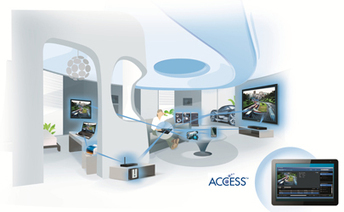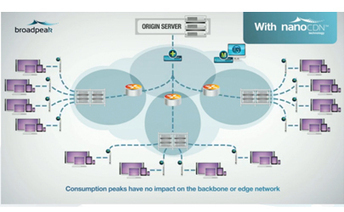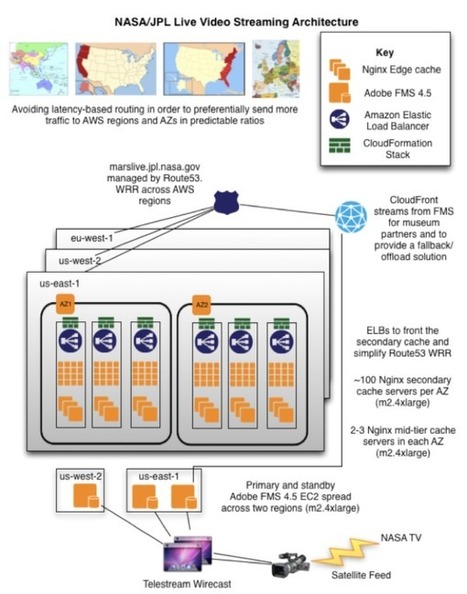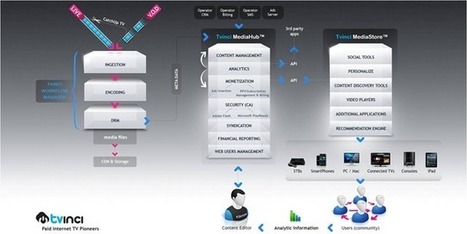 Your new post is loading...
 Your new post is loading...
Low latency with HTTP-streaming (segment-based) technologies is a challenge. In particular MPEG-DASH is gaining adoption among international industry consortiums such as DVB with DVB DASH or ETSI with HbbTV 2.0 (not published yet), with a growing focus on live use-cases. For such applications, latency is a concern. In this article, we will show you how the GPAC team studied the impact on the overhead of HD streaming with very low latency using MPEG-DASH and demonstrated that overhead on the transport side is negligible, in the order of 1%. At 1% overhead, we could demonstrate a 240ms latency. With such a low latency, interactive or bidirectional applications such as video conferencing or live streaming with voting become possible. Of course such low latency can only be safely reproduced in local network conditions. Yet it shows that the latency is not due to the MPEG-DASH technology but rather to the network conditions. It also shows that a few technical choices can dramatically reduce the latency. All the tools used for this demonstration are available as free software.
Via DASH Industry Forum
NAB 2014 wouldn't be the same without Livestream, one of the internet's most popular broadcasting services, introducing new hardware or software. As such, Livestream has just announced another way for users to share video on its site: an application for Google Glass. Obviously, Livestream isn't the first to bring this feature to the wearable set, since you can already use the search giant's own Hangouts app to broadcast what you're seeing.
ACCESS has been presenting a vision of how Pay TV operators can start to marry their broadcast/VOD infrastructure with multiscreen/OTT delivery infrastructure and treat them as a shared resource to optimize the delivery of content to multiple devices around the home, including televisions. It uses its Netfront Living Connect DLNA stack and client software to provide a central view of what each device is capable of and what is currently happening on that device to then manage whole-home resources. Content can be distributed using the new DLNA Commercial Video Profile-2 (CVP-2), which was developed with the cooperation of service providers to enable more secure playback of their content across multiscreen devices. It also gives them more control over the user interface on different devices. CVP-2 leverages HTML5 Remote User Interfaces (RUIs) and HTTP Adaptive Delivery and Authentication on top of the DTCP-IP-based link layer protection, which was already available. ACCESS is actually demonstrating NetFront Living Connect with CVP-2 at the DLNA Members meeting in Hawaii today (Thursday October 10). In this new architecture, DLNA acts as an abstraction layer. Not only does it provide a unified view of activity across diverse devices, it also means platform operators can avoid writing native apps for each DLNA-enabled device. You still need a software client to reach them but not the unique applications development work. “DLNA is a way to overcome device fragmentation,” says Larbey at Alcatel-Lucent.
Broadpeak’s nanoCDN solution will be launched commercially early this year, giving telcos and cable operators the opportunity to reduce bandwidth consumption and simultaneously increase the QoE for customers watching live streaming video on multiscreen devices. This product has the potential to change the economics of streaming but until now there have been only limited details available about how it works and what it can achieve. Broadpeak has just started releasing more details.
As a teaser for my upcoming blog post (“OTT distribution optimization technologies”), here is a bonus study for you, dear readers… It aims at isolating the main OTT Video Services trends (End-user driven & Production driven) and at pointing out relevant technologies with their maturity estimation and corresponding Vendor + Technology offer tuples. Enjoy and share your thoughts/technology suggestions in comments either here or on the blog ! NW
The BBC Olympics sports broadcast service is one of the largest media events of 2012. It has brought the video service industry to a totally new level, earning for the 2012 Olympics the popularity of "truly digital games". In this context, it is critical to acknowledge the importance of expertise gained and leverage it in further growth. In this post, we are going to dwell into the project, its implementation, and valuable experience that you can apply to your own projects.
Whether you're required by law to offer closed captions or not, there's good reason to add them to your online video workflow. Here's how. Though relatively few websites are required to provide closed captions for their videos, any website with significant video content should consider captioning. Not only does it provide access for deaf and hard-of-hearing viewers, but captions and the associated metadata can dramatically improve video search engine optimization. In this introduction to closed captions, you’ll learn about who needs to caption and who doesn’t (and why you may want to anyway), the available workflows for captioning live events and on-demand files, and a bit about web caption formats and how to marry them to your streaming files. Let’s jump in.
nanoStream Web Plugin is a browser based live video capture and encoding software for streaming live video and audio to internet based media servers and other network clients. nanoStream is compatible to latest generation internet video encoding standards and supports Flash and iPod compatible H.264 encoding modes, from low resolution mobile video up to Full HD highest quality video streaming.
Several Extensions are available, for 3d stereoscopic video encoding and streaming from multiple camera views, and additional coding formats; WindowsMedia, MPEG-2 and VP8.
A Videonet special report on : - The impact of more linear TV online - Technology advances to support linear - A more hybrid future for Pay TV
Advances in the live video workflow have opened the doors to IP acquisition and routing, moving us towards 99.9999% reliable live streaming. The question is a common one: “Why is live video so complex, and why should it be any different than the video-on-demand (VOD) content readily available everywhere—including the many thousands of new VOD clips made available on YouTube every day? Simply put: The implications of on-time delivery of live events are significant. Publishing VOD content is not time-sensitive. If we are minutes or even days late publishing VOD content, there is usually no business effect or viewer impact. With live events however, timing is crucial as there are specific business implications and viewers who are waiting to tune into an event looking for a time sensitive result like the winner of the Super Bowl or NBA finals.
Swedish pay TV provider Viaplay has become one of Europe’s first to offer a full hybrid service combining digital terrestrial with OTT. The operator, which is part of the Swedish media company MTG (Modern Times Group), has teamed up with French set top box maker Netgem to develop a dedicated Viaplay box. This delivers a range of free to air terrestrial channels combined with paid premium content delivered over-the-top (OTT). Viaplay says this is the first time a pay-tv operator in the Nordics has combined adaptive bitrate streaming technology and free-to-air digital terrestrial TV in one single channel list with seamless channel change.
HLS is available on iOS and Mac OSX Quicktime Player only. Onlinelib brings HLS to millions of devices with help from Adobe Flash Player. The HLS Streaming Solutions from Onlinelb are ready-to-go solutions : - HLS Player for Adobe Strobe Mediaplayback - HLS SDK for Developers - VCS HLS Hardware Analyzer - HLS Encoder for OSX - VCS Live HLS Encoder
|
Live streaming every phase of every sporting event of the Olympics is a big task. This year NBC expanded their targeted devices to include iOS, Android and Windows smartphones, PCs, Macs, and tablets. The combination of the increased number of live feeds and the increased number of targeted devices creates a complex live video workflow requiring coordination between a number of technologies and partners.
There is also the performance element in that state-of-the-art cloud transcoding platforms can be best for live streaming where latency must be kept to a minimum. Elemental Technologies, exhibiting at NAB, has scored heavily with leading broadcasters by touting high transcoding performance based on massively parallel processing within the cloud. By using clusters of off the shelf graphical processing units, Elemental keeps costs down while being able to boast that it can transcode both SD and HD content “faster than real time”, which is not quite as magic as it sounds. It merely means that transcoding is not on the critical time path and is executed more quickly than some of the other functions involved in end to end content delivery. Transcoding then does not add to the latency budget.
This presentation was made at the MPEG meeting in Shanghai, China, in October 2012, related to the input contribution M26906. It gives the details about the dem
The future is live. The future is real-time. The future is now. That's the hype anyway. And as it has a habit of doing, the hype is slowly becoming reality. We are seeing live searches, live tweets, live location, live reality augmentation, live crab (fresh and local), and live event publishing. One of the most challenging of all live technologies is that of live video broadcasting. Imagine a world in which everyone becomes a broadcaster and a consumer of video streams, all in real-time (< 250 msec latency), all so you can talk and interact directly without feeling like you are in the middle of a time shift war. The resources and the engineering needed to make this happened must be substantial. How do you do that?
BitTorrent has just posted a call for broadcast engineers to help with the building of BitTorrent Live.
BitTorrent Live is a new peer-to-peer live streaming protocol. It allows content creators to scale their reach to audiences of millions with near-zero latencies and minimal infrastructure investment.
“Built with users, from scratch, it’s designed to take the principles of the BitTorrent protocol, and apply them to streaming,” according to BitTorrent’s call to broadcasters, “That means: no barriers to broadcast. That means: the more people who tune in, the more resilient your stream. That means: you can share video with a massive audience, in realtime – without bandwidth costs or infrastructure requirements.
Broadpeak, a leading provider of content delivery networks (CDN) and video-on-demand (VOD) servers for cable, IPTV, OTT, and hybrid TV operators worldwide, today launched nanoCDN, a revolutionary CDN technology that leverages home networks to dramatically reduce infrastructure investments for operators and enable them to more efficiently deliver high-quality video services to end users. The first application of nanoCDN will be used for live OTT video delivery, with more applications to be supported in the future. Broadpeak will showcase nanoCDN for the first time at IBC2012 in Amsterdam. nanoCDN improves the scalability of live OTT TV content by effectively managing video consumption peaks that are not supported by the network infrastructure. Utilizing nanoCDN, cable and telecom operators can cost-effectively deliver high-quality, live OTT video services to millions of simultaneous viewers using only a few megabits per second from the operator network. nanoCDN can seamlessly be integrated with any existing video headend. Completely transparent to end users, the cost-effective solution does not require a dedicated client and is compatible with any DRM system. Product information : http://www.broadpeak.tv/en/technologies/nanocdn-25.php More information : http://bit.ly/RwTaQ5
Over the last few weeks, Windows Azure Media Services was used to deliver live and on-demand video streaming for multiple Olympics broadcasters including: France Télévisions, RTVE (Spain), CTV (Canada) and Terra (Central and South America). Partnering with deltatre, Southworks, gskinner and Akamai - we helped to deliver 2,300 hours of live and VOD HD content to over 20 countries for the 2012 London Olympic games. Below are some details about how these broadcasters used Windows Azure Media Services to deliver an amazing media streaming experience...
In just a few weeks, NASA/JPL was able to design, build, test, and deploy their web hosting and live video streaming solutions that were built using a variety of services on AWS. NASA/JPL’s live video streaming architecture was developed on a combination of Adobe Flash Media Server, Amazon Elastic Compute Cloud (Amazon EC2) instances running the popular nginx caching tier, Elastic Load Balancing, Amazon Route 53 for DNS management, and Amazon CloudFront for content delivery. AWS CloudFormation automates the deployment of live video streaming infrastructure stacks across multiple AWS Availability Zones (AZ) and regions.
Minimizing Server Throughput for Low-Delay Live Streaming in Content Delivery Networks (F. Zhou, S. Ahmad, E. Buyukkaya,R. Hamzaoui and G.Simon)
Now that you intensively crawled through part 1 of this blog-post and asked yourself all the right questions intended to avoid common OTT-traps, we can safely presume that you are ready to spend some (or a lot of) time and money on launching your own multiscreen OTT service. So it’s definitely time to choose your bricks, mortar and trowels... As multiscreen OTT/TV Everywhere offers do proliferate while each video tradeshow approaches and connected devices multiply, it’s difficult to monitor all of them and get a 100% accurate idea on who’s got the best offer. Basically your ideal technical partner will most likely be a unique target depending on your background (telco/content owner/TV channel…), your needs (target devices, business models, time to market…), your workflow constraints (CMS, billing, deployed transcoding engines, already deployed apps…) and your budget. Nevertheless, what I tried to do first is to isolate a list of actors whose offer is end-to-end and sufficiently versatile to cover the most common use cases and devices, then provide a complementary list with actors who provide less information but are also known in this market, and then wrap up the post with a bunch of ideas on how you could DoItYourself with less integrated/locking-in solutions. This way, you will end-up with a complete panorama of available technical solutions in mind.
|



 Your new post is loading...
Your new post is loading...






![OTT Video Services : Trends and Technologies [slide deck] | Video Breakthroughs | Scoop.it](https://img.scoop.it/mEBFuHl9IGk6rcbKiWfvpDl72eJkfbmt4t8yenImKBVvK0kTmF0xjctABnaLJIm9)












![Broadpeak Optimizes Live OTT Video Delivery With Revolutionary nanoCDN Technology [PR] | Video Breakthroughs | Scoop.it](https://img.scoop.it/W0kbhecc-BIEWNlZDC1YPTl72eJkfbmt4t8yenImKBVvK0kTmF0xjctABnaLJIm9)








